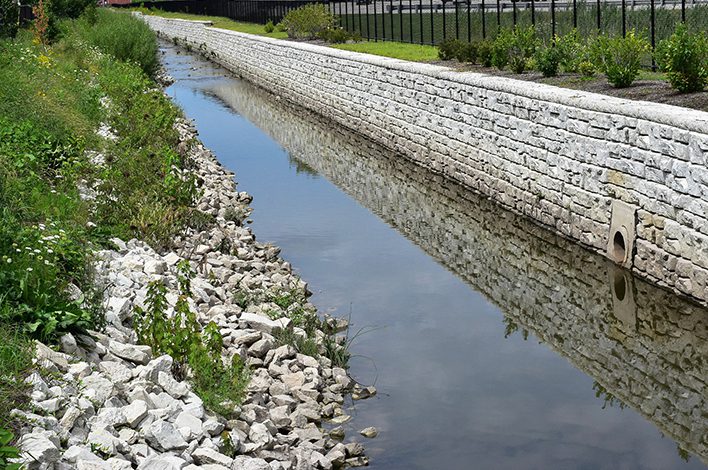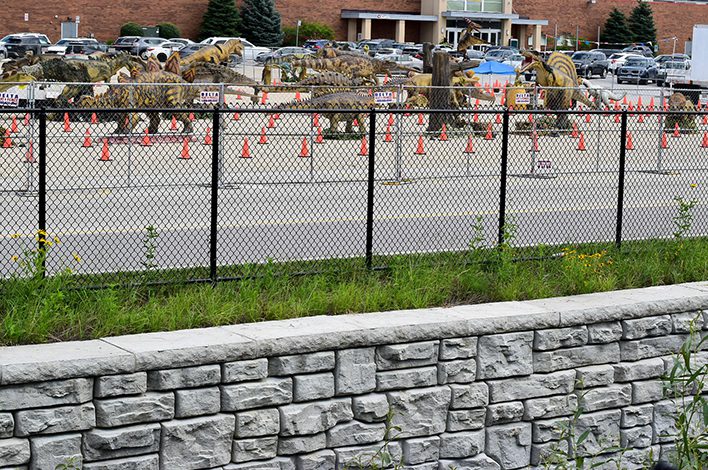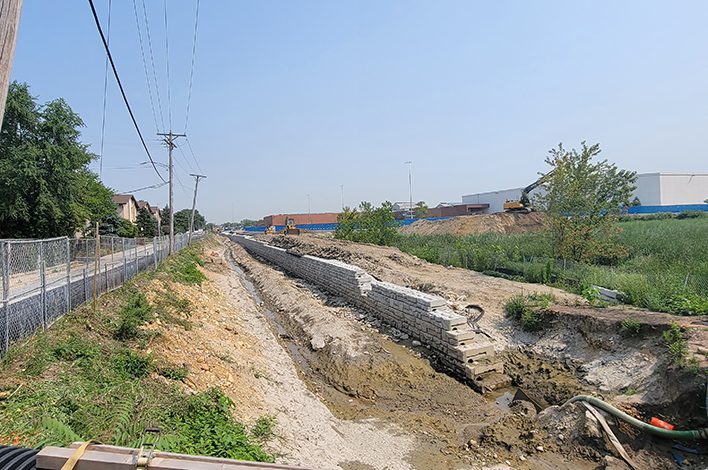More than a half-mile of precast concrete retaining wall offers attractive flood mitigation support in suburban Chicago.
In a recent study conducted using NASA satellite data, researchers found that the proportion of the world’s population exposed to floods has grown by 20% to 24% in just the past two decades. Rising global temperatures, which have increased at an average rate of 0.32 F since 1981, are a major part of the equation.
As temperatures continue to rise, the potential for severe weather events increases, placing a significant burden on commercial and residential properties around the world – and the infrastructure systems that support them. Increased urbanization results in more hardscapes, which increases stormwater runoff.
Add climate-change-induced heavy rain events, and this becomes a challenge for stormwater management infrastructure.
This was the situation in the southwest suburbs of Chicago. The Melvina Ditch Reservoir, originally constructed in 1965 to help mitigate stormwater runoff, could no longer meet the needs.
As a result, the Metropolitan Water Reclamation District (MWRD) of Greater Chicago broke ground in 2018 on an extensive expansion project that would more than double the reservoir’s holding capacity to 117.3 million gallons, reducing flooding risk for more than 400 residential properties in the area.
Part of the work entailed major improvements to the downstream Melvina Ditch, a key stormwater diversion channel connected to the reservoir that diverts runoff water away from the affected neighborhoods.

SETTING UP FOR SUCCESS
Despite being a critical part of the reservoir’s drainage system, little to no work had ever been done to fortify the Melvina Ditch’s walls. This, combined with years of streambank erosion, meant that a resilient, sustainable solution was necessary to complement the expansion work upstream.
Given the nature of the site and the project’s needs, officials with Chicago’s MWRD – in conjunction with general contractor Rausch Infrastructure and installer Cardinal State – selected Redi-Rock precast concrete retaining wall blocks for the work. The team partnered with Brown-Wilbert of Minnesota to manufacture the precast.
While primarily a burial vault producer, Brown-Wilbert picked up some experience with Redi-Rock retaining walls through a previous job in Madison, Wis. The Melvina Ditch project was about twice the size of the Madison work, representing a 2,600-foot stretch of wall and more than 5,600 blocks.
While the work offered a new challenge, Brown-Wilbert Vice President Jeff Bauer said that his team met the task head on, making the necessary modifications to their plant in Sun Prairie, Wis., to accommodate the job’s scale.
Because the concrete had to meet DOT specifications, Bauer and his team partnered with LYCON Inc. and GeoTest. LYCON brought ready-mix trucks into the plant each day to perform a double pour, which was necessary to produce enough blocks to keep pace with the project’s schedule. GeoTest provided the equipment and assessments needed to ensure each Redi-Rock block produced met DOT requirements.
Initially, Brown-Wilbert had to increase the number of forms used inside its Sun Prairie location from 20 to 30. This meant rearranging the plant a few times to establish the most efficient logistical setup. Additionally, due to the effects of COVID at the time, Brown-Wilbert also was producing more burial vaults than usual.
Despite the difficulties and extenuating circumstances surrounding the effort, the Brown-Wilbert team successfully implemented a working system.
“Once we worked through some of the initial difficulties, we established a solid routine,” Bauer said. “At that point, for the rest of the project period, it was pretty much going through the motions.”

LESS LABOR, MORE EFFICIENCY
At the project site in Chicago Ridge, Cardinal State encountered challenges of its own. Drawings associated with the ditch were not accurate, resulting in many of the utilities located on-site being unaccounted for. There also were schedule hiccups.
“If it rained on a Monday, we’d shut down work for that day,” Cardinal State President Roger Wiese said. “But then on Wednesday, two days after the rain event, water from the reservoir would be released and flood the ditch again. Essentially, each rain day was doubly detrimental due to that second wave of water being released.”
All parties involved knew that precast concrete was the best building material for the job, as it allowed Wiese and his team to get the work done with extreme precision and efficiency.
“With the precast, it is delivered to the site as blocks, so we’re literally unloading them from a truck and putting them right in place,” Wiese said.
Wiese added that the entire process is streamlined thanks to the way the precast concrete Redi-Rock blocks are designed.
“It’s just a better system,” he said. “Everything connects with simplicity, almost like Lego blocks. In the end, precast is more cost effective to install, performs better and lasts longer.”
In addition to addressing the flooding needs of the area, the blocks, which were poured with a Ledgestone texture, offer an aesthetic improvement from the Melvina Ditch’s previous appearance, which largely consisted of grass and weeds. This represents a source of pride for Brown-Wilbert, whose products typically are used underground and are out of sight.
“We can finally see our work,” Bauer said. “And honestly, in addition to addressing a difficult problem for those in the area, that’s one of the most gratifying things about this project.”
All parties worked closely together, keeping in constant communication throughout the process, to ensure that the project was completed on time. Installation took approximately six months and was completed in December 2021.
Due to the effectiveness of the system installed, the project was recognized by Stormwater Solutions as one if its Top 10 of 2022.
BEAUTY AND SECURITY FOR GENERATIONS TO COME
While the risk of flooding will continue to present issues in cities across the United States and around the world, much can be accomplished by bolstering infrastructure systems with the use of precast concrete products.
Both Bauer and Wiese said that the Melvina Ditch project has inspired their companies to pursue similar projects in the future and serve the communities facing these issues.
“This process was ideal for us,” Wiese said. “After completing Melvina Ditch, we’re now bidding on every single one of these projects that comes our way.”
Bauer agreed, noting that the positive effects generated through the Melvina Ditch retaining wall are far-reaching and long-lasting.
“Residents in the area received the benefit of a water retention retaining wall that adds beauty to the neighborhood while providing security from erosion for generations to come,” he said.
